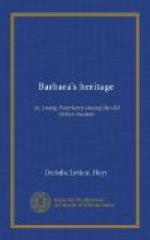“I do see the difference between this and those Academy pictures,” said Bettina, “even though it is so queer, and painted in such colors.”
“And I,” “And I,” quickly added Barbara and Margery.
“I think those angels’ faces are interesting,” continued Barbara. “They are not all just alike, but look as if each had some thought of his own. They seem proud of their burden as they hold up the Madonna and Child.”
“Oh, nonsense, Barbara! you are putting too much imagination in there,” exclaimed Malcom. “I think old Cimabue did do something, but it is an awfully bad picture, after all. There is one thing, though; it is not so flat as that Academy Magdalen. The child’s head seems round, and I do think his face has a bit of expression.”
So they looked and chatted on, and took little note of coming and going tourists, who glanced with curiosity from them to the old dark picture above, and then back to the fresh, eager, beautiful faces,—the greater part ever finding in the latter the keener attraction.
“I always have one thought when I look at this,” finally said Mr. Sumner, “that perhaps will be interesting to you, and linger in your minds. This Madonna and Child seems to form a link and also to mark a division between all those which went before it in Christian art and all those that have followed. It is the last Byzantine Madonna and is the first of the long, noble list which has come from the hands of artists who have lived since the thirteenth century.
“We will not stay here longer now, for I know you will come again more than once to study it. There is much valuable historic art in this church which you will understand better when you have learned more. Yonder in the Strozzi Chapel is some of the very best work of an old painter called Orcagna, while here in the choir are notable frescoes by Ghirlandajo; but now I shall take you down these steps between the two into the cloister and there we will talk of Giotto. I know how busy you have been reading about this wonderful old master, for I could not help hearing snatches of your talk about him all through the past week. His figure looms up most important of all among the early painters of Florence. You know how Cimabue, clad in his scarlet robe and hood, insignia of nobility, riding out one day to a little town lying on one of yonder blue hills, found a little, dark-faced shepherd-boy watching his father’s sheep, and amusing himself by drawing a picture of one, with only a sharp stone for a pencil. Interested in the boy, he took pains to visit his father and gain his permission to take him as a pupil to Florence. So Giotto came to begin his art-life. What are you thinking of, little Margery?”
“Only a bit of Dante’s writing which I read with mother the other day,” said she, blushing. “I was thinking how little Cimabue then thought that this poor, ignorant shepherd-boy would ever cause these lines to be written:—




